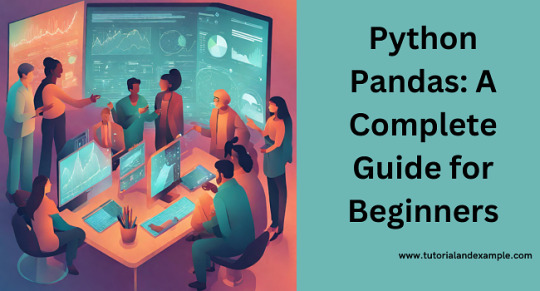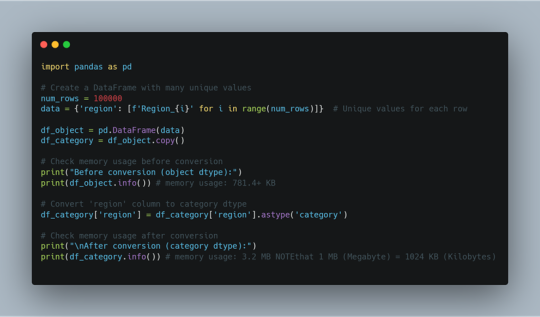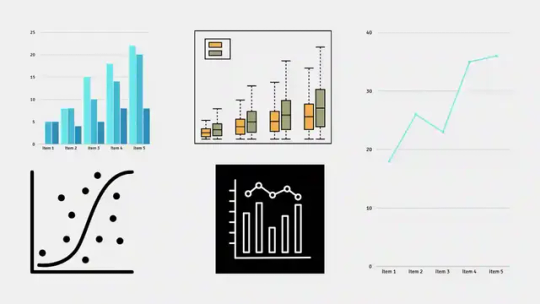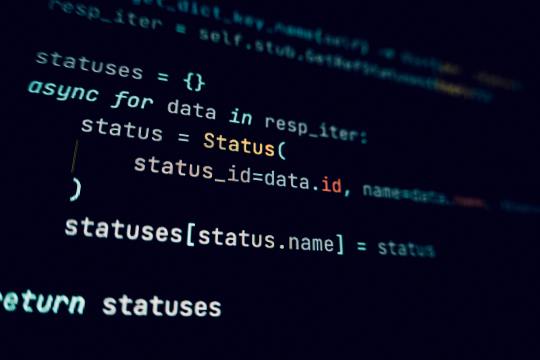#Learn Python Pandas
Explore tagged Tumblr posts
Text
Unlock the Power of Pandas: Easy-to-Follow Python Tutorial for Newbies

Python Pandas is a powerful tool for working with data, making it a must-learn library for anyone starting in data analysis. With Pandas, you can effortlessly clean, organize, and analyze data to extract meaningful insights. This tutorial is perfect for beginners looking to get started with Pandas.
Pandas is a Python library designed specifically for data manipulation and analysis. It offers two main data structures: Series and DataFrame. A Series is like a single column of data, while a DataFrame is a table-like structure that holds rows and columns, similar to a spreadsheet.
Why use Pandas? First, it simplifies handling large datasets by providing easy-to-use functions for filtering, sorting, and grouping data. Second, it works seamlessly with other popular Python libraries, such as NumPy and Matplotlib, making it a versatile tool for data projects.
Getting started with Pandas is simple. After installing the library, you can load datasets from various sources like CSV files, Excel sheets, or even databases. Once loaded, Pandas lets you perform tasks like renaming columns, replacing missing values, or summarizing data in just a few lines of code.
If you're looking to dive deeper into how Pandas can make your data analysis journey smoother, explore this beginner-friendly guide: Python Pandas Tutorial. Start your journey today, and unlock the potential of data analysis with Python Pandas!
Whether you're a student or a professional, mastering Pandas will open doors to numerous opportunities in the world of data science.
0 notes
Text

Discover the Python Pandas Tutorial for Beginners and learn how to easily manage and analyze data. This beginner-friendly guide covers all the basics. For a detailed tutorial, visit TAE.
0 notes
Text
Memory Optimization in Pandas: Why category Sometimes Uses MORE Memory!
Have you ever tried converting a Pandas column to category dtype, expecting less memory usage only to find it increased instead? 🤯 Let’s break it down! Using dtype={'column': 'category'} should reduce memory usage because: ✅ It stores unique values separately and uses integer codes to reference them. ✅ It works best for columns with many repeated values (e.g., product categories, country names). Hidden Insight 🔎 : If your dataset has many unique values, category dtype adds overhead instead of saving space. Here's why: ❌ Every unique value needs its own entry in the category mapping. ❌ If your column had short text values (e.g., 'NY', 'CA'), the original object type was already optimized. ❌ category needs extra storage for mapping each value to an integer index. You can run a quick test to see memory usage differences as given in the code.

In short; If the column has repeated values, category saves space. If the column has mostly unique values, category uses more memory than object. Use category only when: 👉 The column has a limited number of unique values (e.g., department, product type). 👉 You plan to group, filter, or analyze categories frequently. 👉 The column was using object dtype and taking up too much space. ⚡ What Are Your Thoughts? Have you noticed 'category' data type using more memory in your projects? Share your experience!
0 notes
Text
Project Title: Advanced Anomaly Detection and Outlier Analysis with Pandas and Machine Learning
File Name: advanced_anomaly_detection_and_outlier_analysis_with_pandas_and_ml.py Project Description This project focuses on advanced anomaly detection and outlier analysis, combining Pandas for data manipulation with machine learning techniques for predictive modeling. The goal is to build a system that can: Data Preprocessing: Clean and prepare the data using Pandas, including missing value…

View On WordPress
0 notes
Text
Project Title: Advanced Anomaly Detection and Outlier Analysis with Pandas and Machine Learning
File Name: advanced_anomaly_detection_and_outlier_analysis_with_pandas_and_ml.py Project Description This project focuses on advanced anomaly detection and outlier analysis, combining Pandas for data manipulation with machine learning techniques for predictive modeling. The goal is to build a system that can: Data Preprocessing: Clean and prepare the data using Pandas, including missing value…

View On WordPress
0 notes
Text
Project Title: Advanced Anomaly Detection and Outlier Analysis with Pandas and Machine Learning
File Name: advanced_anomaly_detection_and_outlier_analysis_with_pandas_and_ml.py Project Description This project focuses on advanced anomaly detection and outlier analysis, combining Pandas for data manipulation with machine learning techniques for predictive modeling. The goal is to build a system that can: Data Preprocessing: Clean and prepare the data using Pandas, including missing value…

View On WordPress
0 notes
Text
Project Title: Advanced Anomaly Detection and Outlier Analysis with Pandas and Machine Learning
File Name: advanced_anomaly_detection_and_outlier_analysis_with_pandas_and_ml.py Project Description This project focuses on advanced anomaly detection and outlier analysis, combining Pandas for data manipulation with machine learning techniques for predictive modeling. The goal is to build a system that can: Data Preprocessing: Clean and prepare the data using Pandas, including missing value…

View On WordPress
0 notes
Text
Project Title: Advanced Anomaly Detection and Outlier Analysis with Pandas and Machine Learning
File Name: advanced_anomaly_detection_and_outlier_analysis_with_pandas_and_ml.py Project Description This project focuses on advanced anomaly detection and outlier analysis, combining Pandas for data manipulation with machine learning techniques for predictive modeling. The goal is to build a system that can: Data Preprocessing: Clean and prepare the data using Pandas, including missing value…

View On WordPress
1 note
·
View note
Text
Me when I manage to bypass the obstacles the interface has placed on me and finally gain access to the forbidden texts
(I wasn’t able to install pandas and it took me an hours and multiple YouTube videos to find the problem and just change one property)

#uni talks about the universe#coding#python#pandas#I now realize typing that that it’s probably not going to reach the python and pandas I was intending#eh#also#it might be a stretch#but with the HOURS of videos I have watched and literally only one graph I’ve been able to produce#I don’t think I’m good at coding guys#*looks at the multiple classes that require coding for my degree*#I may have a problem on my hands#but that’s a future me problem#right now me problem is learning what the fuck do I even do with pandas
0 notes
Text
It’s so weird to work in python when I’ve been doing mostly java and c nonesense this year bc it just feels so wrong to have no semicolons.
It also doesn’t help when I don’t have the correct library and so my IDE is highlighting the end of a line as if it needs a semi colon
#idk it feels so emptyyyyy#I like Python but man I don’t use it a lot these days#I’ve only had to use it a couple of times this year bc of doing machine learning pandas work#but now it’s all I’m doing for a few days. bc I’m doing more pandas shit#gritting my teeth as I use pycharm which isn’t that bad but does sometimes just poss me off#but idk how to get the libraries I need to do this work in idle XD
1 note
·
View note
Text
Python Regular Expression
Unleash the power of Python's re module with these regex examples! From checking website URLs to extracting data and even text manipulation, this tutorial has got you covered. Level up your text processing skills with Python at @p4n.in #Python #Regex #
Introduction to the re Module Regular expressions, often abbreviated as regex or regexp, are sequences of characters that define a search pattern. They are widely used in text processing tasks such as pattern matching, search and replace operations, and validation of input data. In Python, the re module provides support for working with regular expressions. re — Regular Expression…
View On WordPress
0 notes
Text
What is Pandas in Python?
Introduction What is Pandas? What does the name “Pandas” stand for? Why use Pandas? Getting Started with Pandas Installing Pandas Creating your first DataFrame Exploring and manipulating data in DataFrames Key Features of Pandas Data Structures Data Manipulation and Analysis Visualization Conclusion Summary of key benefits Why Pandas is essential for Python data science FAQs What is…

View On WordPress
0 notes
Text
Ok but like… I hate to be that guy, but R has libraries for literally everything data sci/stats related you could need. I was doing stats hw earlier, (yes I know general stats isn’t exactly the same as bio informatics) and for literally every problem, the solution was literally 1 line of R code, and it took like 2 mins to identify the proper function and apply it.
I'm the best language for bioinformatics and if you even mention R I will murder you in your sleep
#I will give it that python is much easier to write code in if what u need doesn’t already have a prebuilt library#which probably is a huge pro for python for bioinformatics specifically#because I imagine that R probably has fewer (but still many) libraries for bio informatics than it does for general stats#and also machine learning stuff is much easier to apply in Python which is another boon in its favor#but R also has machine learning stuff#also python wishes it was R so badly that it literally has a whole library dedicated to mimicking R#(yes this is about pandas)#also like#I wouldn’t be very upset being murdered in my sleep
176 notes
·
View notes
Text
instagram
Learning to code and becoming a data scientist without a background in computer science or mathematics is absolutely possible, but it will require dedication, time, and a structured approach. ✨👌🏻 🖐🏻Here’s a step-by-step guide to help you get started:
1. Start with the Basics:
- Begin by learning the fundamentals of programming. Choose a beginner-friendly programming language like Python, which is widely used in data science.
- Online platforms like Codecademy, Coursera, and Khan Academy offer interactive courses for beginners.
2. Learn Mathematics and Statistics:
- While you don’t need to be a mathematician, a solid understanding of key concepts like algebra, calculus, and statistics is crucial for data science.
- Platforms like Khan Academy and MIT OpenCourseWare provide free resources for learning math.
3. Online Courses and Tutorials:
- Enroll in online data science courses on platforms like Coursera, edX, Udacity, and DataCamp. Look for beginner-level courses that cover data analysis, visualization, and machine learning.
4. Structured Learning Paths:
- Follow structured learning paths offered by online platforms. These paths guide you through various topics in a logical sequence.
5. Practice with Real Data:
- Work on hands-on projects using real-world data. Websites like Kaggle offer datasets and competitions for practicing data analysis and machine learning.
6. Coding Exercises:
- Practice coding regularly to build your skills. Sites like LeetCode and HackerRank offer coding challenges that can help improve your programming proficiency.
7. Learn Data Manipulation and Analysis Libraries:
- Familiarize yourself with Python libraries like NumPy, pandas, and Matplotlib for data manipulation, analysis, and visualization.
For more follow me on instagram.
#studyblr#100 days of productivity#stem academia#women in stem#study space#study motivation#dark academia#classic academia#academic validation#academia#academics#dark acadamia aesthetic#grey academia#light academia#romantic academia#chaotic academia#post grad life#grad student#graduate school#grad school#gradblr#stemblog#stem#stemblr#stem student#engineering college#engineering student#engineering#student life#study
7 notes
·
View notes
Text
Python for Beginners: Launch Your Tech Career with Coding Skills
Are you ready to launch your tech career but don’t know where to start? Learning Python is one of the best ways to break into the world of technology—even if you have zero coding experience.
In this guide, we’ll explore how Python for beginners can be your gateway to a rewarding career in software development, data science, automation, and more.
Why Python Is the Perfect Language for Beginners
Python has become the go-to programming language for beginners and professionals alike—and for good reason:
Simple syntax: Python reads like plain English, making it easy to learn.
High demand: Industries spanning the spectrum are actively seeking Python developers to fuel their technological advancements.
Versatile applications: Python's versatility shines as it powers everything from crafting websites to driving artificial intelligence and dissecting data.
Whether you want to become a software developer, data analyst, or AI engineer, Python lays the foundation.
What Can You Do With Python?
Python is not just a beginner language—it’s a career-building tool. Here are just a few career paths where Python is essential:
Web Development: Frameworks like Django and Flask make it easy to build powerful web applications. You can even enroll in a Python Course in Kochi to gain hands-on experience with real-world web projects.
Data Science & Analytics: For professionals tackling data analysis and visualization, the Python ecosystem, featuring powerhouses like Pandas, NumPy, and Matplotlib, sets the benchmark.
Machine Learning & AI: Spearheading advancements in artificial intelligence development, Python boasts powerful tools such as TensorFlow and scikit-learn.
Automation & Scripting: Simple yet effective Python scripts offer a pathway to amplified efficiency by automating routine workflows.
Cybersecurity & Networking: The application of Python is expanding into crucial domains such as ethical hacking, penetration testing, and the automation of network processes.
How to Get Started with Python
Starting your Python journey doesn't require a computer science degree. Success hinges on a focused commitment combined with a thoughtfully structured educational approach.
Step 1: Install Python
Download and install Python from python.org. It's free and available for all platforms.
Step 2: Choose an IDE
Use beginner-friendly tools like Thonny, PyCharm, or VS Code to write your code.
Step 3: Learn the Basics
Focus on:
Variables and data types
Conditional statements
Loops
Functions
Lists and dictionaries
If you prefer guided learning, a reputable Python Institute in Kochi can offer structured programs and mentorship to help you grasp core concepts efficiently.
Step 4: Build Projects
Learning by doing is key. Start small:
Build a calculator
Automate file organization
Create a to-do list app
As your skills grow, you can tackle more complex projects like data dashboards or web apps.
How Python Skills Can Boost Your Career
Adding Python to your resume instantly opens up new opportunities. Here's how it helps:
Higher employability: Python is one of the top 3 most in-demand programming languages.
Better salaries: Python developers earn competitive salaries across the globe.
Remote job opportunities: Many Python-related jobs are available remotely, offering flexibility.
Even if you're not aiming to be a full-time developer, Python skills can enhance careers in marketing, finance, research, and product management.
If you're serious about starting a career in tech, learning Python is the smartest first step you can take. It’s beginner-friendly, powerful, and widely used across industries.
Whether you're a student, job switcher, or just curious about programming, Python for beginners can unlock countless career opportunities. Invest time in learning today—and start building the future you want in tech.
Globally recognized as a premier educational hub, DataMites Institute delivers in-depth training programs across the pivotal fields of data science, artificial intelligence, and machine learning. They provide expert-led courses designed for both beginners and professionals aiming to boost their careers.
Python Modules Explained - Different Types and Functions - Python Tutorial
youtube
#python course#python training#python#learnpython#pythoncourseinindia#pythoncourseinkochi#pythoninstitute#python for data science#Youtube
3 notes
·
View notes
Text
Why Learning Python is the Perfect First Step in Coding
Learning Python is an ideal way to dive into programming. Its simplicity and versatility make it the perfect language for beginners, whether you're looking to develop basic skills or eventually dive into fields like data analysis, web development, or machine learning.
Start by focusing on the fundamentals: learn about variables, data types, conditionals, and loops. These core concepts are the building blocks of programming, and Python’s clear syntax makes them easier to grasp. Interactive platforms like Codecademy, Khan Academy, and freeCodeCamp offer structured, step-by-step lessons that are perfect for beginners, so start there.
Once you’ve got a handle on the basics, apply what you’ve learned by building small projects. For example, try coding a simple calculator, a basic guessing game, or even a text-based story generator. These small projects will help you understand how programming concepts work together, giving you confidence and helping you identify areas where you might need a bit more practice.
When you're ready to move beyond the basics, Python offers many powerful libraries that open up new possibilities. Dive into pandas for data analysis, matplotlib for data visualization, or even Django if you want to explore web development. Each library offers a set of tools that helps you do more complex tasks, and learning them will expand your coding skillset significantly.
Keep practicing, and don't hesitate to look at code written by others to see how they approach problems. Coding is a journey, and with every line you write, you’re gaining valuable skills that will pay off in future projects.
FREE Python and R Programming Course on Data Science, Machine Learning, Data Analysis, and Data Visualization

#learntocode#python for beginners#codingjourney#programmingbasics#web development#datascience#machinelearning#pythonprojects#codingcommunity#python#free course
10 notes
·
View notes